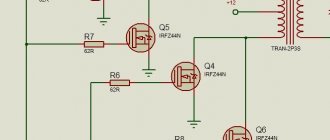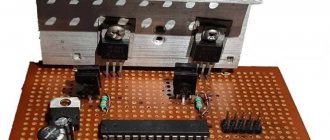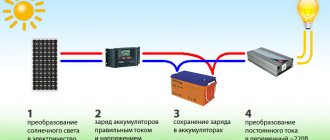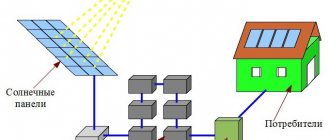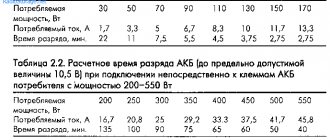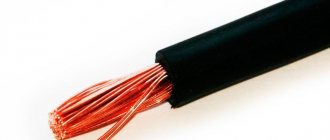The inverter, which replaced conventional welding transformers, is a modern electronic device, the characteristics of which allow it to be used for welding work using various technologies. In addition to the basic characteristics characteristic of transformer-type welding machines, inverters also have a number of additional capabilities, which makes their use more convenient and significantly expands their technical capabilities. Thanks to this, such equipment can be used equally successfully in both industrial and home environments.
Welding inverter “Svarog” ARC-200
How does an inverter-type welding machine work?
Due to its technical characteristics, the inverter can be used to perform welding with various types of electrodes. This device is distinguished by its compact size and light weight, which makes it very mobile, unlike heavy and large transformers. It is also convenient that such a welder can generate both direct and alternating current.
In order to understand what advantages an inverter has, you need to understand how it works. The operation of this device, which began to gain mass popularity only at the beginning of the 21st century, is based on a completely different principle compared to the operation of a conventional welding transformer.
Schematic diagram of the welding inverter "Duga-200" (click to enlarge)
The alternating current supplied to the inverter from a regular electrical network is first rectified by passing through a diode bridge, which is equipped with the electrical circuit of the device. After rectification, the direct current is supplied to power transistors, which convert it back into alternating current, but with an increased frequency. To reduce the voltage of high-frequency alternating current and obtain the welding current of the required strength, a transformer is used in the electrical circuit of the inverter.
Since the voltage reduction of high-frequency current is not carried out according to the same principle as in a conventional welding machine, there is no need to use large transformers for this; a compact device is quite sufficient. After reducing the voltage and increasing the current to the required value, it is supplied to the output rectifier, in which it is converted to constant.
Inverter controls using the example of the Fast and the Furious device (click to enlarge)
The use of high-frequency current generated by the inverter not only makes it possible to significantly reduce the dimensions of the device, but also has a positive effect on the combustion process of the welding arc, which is highly stable. Such a welding machine is characterized by high efficiency, since it does not waste energy on heating the transformer iron.
Simplified diagram of the operation of a welding inverter
Thus, any inverter device consists of such structural elements as:
- a rectifier assembled on the basis of a diode bridge (this electrical circuit block is responsible for rectifying the alternating current coming from the electrical network);
- the inverter itself, which is a generator of high-frequency electrical pulses (the basis of this unit is made up of transistors that open and close at high frequencies);
- a step-down transformer, which solves the problem of lowering the high-frequency voltage and, accordingly, increasing the welding current;
- high-frequency output current rectifier (such a rectifier, like the input unit, is assembled on the basis of a diode bridge);
- a special electronic unit designed to control the operating modes of the inverter apparatus.
Principle of operation
The inverter operates on a simple principle, which can be understood by giving a specific example.
A conventional battery operates primitively and produces a constant flow of current that does not change its direction. If you add a switch to this design, which at the output will change the direction of electron movement, then AC will flow to the device. To make it correct, the switch must work properly and operate at least 50 times within a second. About 3,000 changes in the flow of electrons occur per minute. A mechanical inverter works somewhat differently and, using special magnets, also quickly changes the direction of the current. The principle of its operation is reminiscent of a doorbell. When a button is pressed, a person acts on a spring, which sends a signal to change the power and flow of electricity. When released, everything returns to its original position. The device is also equipped with a special controller that performs other functions:
- voltage regulation in the device;
- switching frequency synchronization;
- providing protection against overloads and breakdowns.
Thanks to this, even the mechanical model of the device allows large electrical appliances to operate uninterruptedly.
Technical capabilities of inverter devices
Any inverter, being a welding machine, serves to ignite the welding arc and maintain its combustion in a stable state. Due to the features of its design, the inverter device copes with this task perfectly. In addition to the main function, modern inverter models are equipped with a number of additional options that make their use as convenient and comfortable as possible. These include:
- “Hot start” (this option allows you to ignite the welding arc faster, which is achieved by applying an additional electrical pulse to the electrode);
- “Arc force” (this function assumes that when the electrode suddenly approaches the surface of the parts being welded, the welding current automatically increases, which prevents the electrode from sticking in such a situation);
- “Anti-sticking” (this option works as follows: when the electrode sticks, the electric current stops flowing to it; it starts flowing only when the electrode is torn off from the surface of the parts being connected).
Front panel of the welding inverter "BIMark-170"
Some models of inverter devices are also equipped with overheating indicators and an automatic shutdown option if overheating does occur. This useful function protects such an expensive device as an inverter from burning out and, as a result, from costly repairs.
The additional options described above are especially useful for novice welders, as they help minimize the impact of a specialist’s skill level on the quality of welding.
Types of inverters on the modern market
Welding inverters on the market today can be divided into two main types.
Household
A device such as a household inverter is designed to perform periodic welding work. These devices are inexpensive, but they can be used from time to time; they are not intended for intensive daily work. Such inverters are optimal if you sometimes need to perform simple and short-term welding work. Most of these devices are made in China.
Professional
Such equipment is intended for daily long-term use; its design is initially designed for active use. The cost of these inverters, naturally, is quite high, but it is adequate to their quality characteristics.
The market also offers semi-professional inverter devices, which, in terms of their technical characteristics and cost, are between household and professional equipment. In addition to the above types, there are universal devices, which are also called combined. Their versatility lies in the fact that they can be used to perform welding using various technologies. Due to its wide functionality, such inverter equipment also falls into the professional category.
In what areas is a 12-220 V voltage inverter used?
With stable use of the battery, its charge level gradually decreases. The converter stabilizes the voltage if there is no electricity.
A 12-220 V inverter, made by yourself, will allow you to improve engineering structures in any room. The power value of devices that convert current is selected according to the total values of the operated loads. Power consumption processes can be reactive or active. Reactive loads do not fully consume the amount of energy received, causing the apparent power value to be greater than its active value.
Pure sine wave inverters are used when connecting an element whose total power is 3 kW. Significant fuel savings are ensured by the use of voltage converters and mini-power plants.
The following consumers are connected to the inverter design:
- alarm system;
- boiler;
- pumping apparatus;
- computer system.
Technical characteristics of inverter devices
When choosing an inverter, they are primarily guided not by its cost, but by its technical characteristics. Whether you can use such a device to perform the work for which it was purchased depends on how correctly they are selected.
The most important characteristic of any welding machine (and the inverter is no exception) is the current strength that such equipment allows to obtain. This parameter affects the thickness of the part you can weld using an inverter device. There is no point in overpaying for a powerful machine if you plan to use it only for welding thin parts made of ferrous metal.
Dependence of welding current and electrodes used on metal thickness
An important parameter is not only the maximum value of the welding current, but also its minimum value. Welding of thin sheet metal is performed at minimum current. It is also necessary to take into account how the welding current is regulated - in a stepwise or smooth pattern. Adjusting the current according to a smooth scheme is naturally more convenient.
The ease of ignition of the welding arc has a key influence on a parameter such as open circuit voltage. The higher it is, the easier it will be to ignite the arc.
The type of electrical current that powers the inverter device is another parameter that must be taken into account. On the modern market there are inverters that can operate from an electrical network with a voltage of 220 and 380 V. Naturally, for domestic use it is more advisable to choose equipment that operates from a network with a voltage of 220 V.
Single-phase converters
They differ in the characteristics of the sinusoidal output voltage. More serious models are capable of producing a sinusoid close to the standard mains voltage. Another group of inverters produces a graph in a simplified form, which more closely resembles a trapezoidal shape.
The structure of the voltage sinusoid plays an important role for many household appliances.
Some of them do not operate on voltage supplied via a simplified sine wave. It is important for devices with:
- electric motors;
- transformers;
- telecommunication devices.
In addition, some medical equipment, audio and video equipment simply will not work if the output voltage is incorrect. Typically, inverters operate in three modes. During long-term operation, the rated power of the unit is used.
In short-term overload mode, energy consumption may be 1.5 times the rated power. During the starting mode, increased power is instantly released, which is used to start electric motors and other loads with increased capacity.
Advantages and disadvantages of inverters
The high popularity of inverters is explained by a number of advantages that they have.
- Inverters are distinguished by high power and a wide range of welding current regulation. — Even when the work is performed by a not very highly qualified specialist, inverter devices make it possible to obtain welds of high quality, reliability and attractive appearance.
- Inverters are compact in size and light in weight. — Devices of this type have high efficiency and, as a result, consume electrical energy economically.
- During welding with an inverter, the molten metal is splashed very slightly, which helps to save consumables and form neat welds.
- The versatility of inverter machines is undeniable, thanks to which they can be used to perform welding using different technologies.
Inverters also have disadvantages, the most significant of which include the following.
- Inverters are quite expensive when compared to conventional welding transformers.
- If they fail, inverter devices are very expensive to maintain.
- Inverters, whose design is based on complex electronic circuits, react very critically to dust, high humidity and low temperatures. That is why the scope of use of such devices is quite limited. For their trouble-free operation, it is necessary to create special conditions and devote a lot of time to their maintenance (cleaning from dust, etc.).
- Complete with inverter devices, wires whose length does not exceed 2.5 meters can be used. Such short wires are also factors that seriously limit the application range of inverters.
Overall, if you weigh the pros and cons of using inverters for welding, the benefits will be significantly greater. The design of the equipment ensures rapid ignition of the welding arc and its stable combustion during the work process, and thanks to its technical capabilities, inverters make it possible to obtain high-quality, reliable and accurate connections with electrodes of any type.
Popular models
To simplify the choice, we will consider several models of autonomous inverters, highlighting their nuances and parameters.
Inverter / UPS SILA EP20-300
Model SILA EP20-300 is a universal equipment that combines the options of an uninterruptible power supply, charger and converter.
It is possible to automatically switch the modes of input U from the battery or from the network. Ensures continuous operation of connected equipment.
The inverter is used as a UPS (if there is a battery) or in conjunction with a solar power plant (an external charge controller is required). Country of origin: Taiwan.
Main parameters:
- Protection against short circuit, high and low voltage.
- Fast switching - 6 ms.
- Autostart after protection operation.
- LCD display.
- Automatic charging (3-step): constant current/voltage, charge support.
- Pure sine output.
Characteristics:
- Large U range at the output - from 140 to 280 V.
- Current adjustment - from 5 to 10 A (set by program).
- Stabilization of U at the output.
- Nominal / maximum power - 300 / 900 W.
- Battery voltage is 12 V.
- Efficiency - 90%.
- Personal consumption - 24 W.
- Warranty - 2 years.
Model SILA EP20-300 is capable of operating at humidity levels from 0 to 90% and over a wide temperature range. The dimensions of the autonomous inverter are only 31.5x14.5x21 cm, and the weight is 7.5 kg. Similar models with power of 600 and 1000 W are available for sale.

